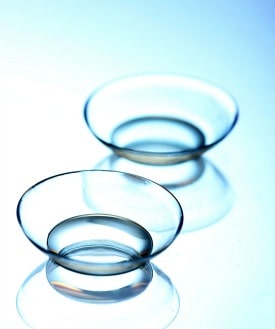What are the different types of contact lenses?
Contact lenses can be grouped together based on several characteristics:
- Lens material — Soft, gas permeable (GP) or hybrid

- Oxygen permeability — "Silicone hydrogel" lenses like clariti 1 day offer high levels of oxygen to your cornea, and are what most newer lenses are made from. "Hydrogel" lenses are mostly older technology and generally offer lower levels of oxygen.
- Wear schedule — That is, whether you take them out before sleep. Certain lenses are FDA approved for extended (overnight) wear; daily wear lenses should be removed before sleeping or napping.
- Replacement schedule, or how often you discard them and begin wearing a fresh pair. Daily disposable lenses are discarded every day and require no care, making them a hassle-free option for teens. Monthly and two-week replacement schedules are most popular.
In addition to the above, lenses come in colors and in designs for people who need bifocals or have astigmatism.
How do I decide on the right lenses?
Your doctor can help you decide which combination of features is right for your teen. In addition to your teen's preferences, the doctor will evaluate his or her eye structure, tears, and visual acuity to determine what lenses will be healthy and comfortable.
If you have astigmatism or a strong prescription, don't you have to wear glasses instead?
Not anymore! That may have been true years ago, but now contact lenses are manufactured in designs that work for nearly everyone, including people with astigmatism. Soft contact lenses designed to correct astigmatism are called toric soft lenses, and disposable versions are available like clariti 1 day toric.
Is LASIK a better option for teens than contact lenses?
LASIK is not an option for teenagers. The U.S. Food and Drug Administration ( FDA) has set the minimum age for laser vision correction at 18 (or 21 for some procedures). One big reason is that teens' eyes may still be changing from one year to the next. For example, during high school and college years, nearsightedness may worsen a bit each year, until the eyes "settle" into a somewhat final prescription around the mid-20s. When the eyes are changing so rapidly, it doesn't make sense to perform LASIK on them, because the effect of the surgery will not last.
What if contact lenses just don't work out?
Sometimes parents let their teen wear contacts for a trial period, so they can prove they are ready for the responsibility. If it doesn't work out, the teen can always go back to wearing glasses and re-try contact lenses later on.
Part-time wear is also an option, and daily disposables are especially good for this.
HOW TO PREPARE FOR A CONTACT LENS FITTING
Be ready to spend an hour or more at the eye care practitioner's office.
A contact lens fitting may be performed as part of a complete eye exam, or it may be performed separately sometime afterward. If combined with a comprehensive exam, the total time required may be 60 to 90 minutes or longer.
Bring sunglasses.
If your eye exam and contact lens fitting are performed together, your pupils may be dilated so your eye doctor can thoroughly examine the health of your eyes. After dilation, your eyes may be sensitive to light for a few hours.
Bring a list of questions and ask all of them.
This is your chance to take advantage of your eye care practitioner's expertise! He or she will be happy to answer all your questions, so don't hold back — even if you think some of your questions may be trivial.
Understand that eyeglasses may be the best option for the time being.
Once in a while an eye care practitioner may feel that a teen isn't ready for contact lenses. Or contacts may not be right for someone's particular prescription or lifestyle. Even if contact lenses are not the best option for now, they may be in the future.
Contact lens basics: Types of contact lenses and more By Liz Segre
Make your appointment today
To make your appointment, simply give us a call (760)-948-3345 or
or
Due to COVID-19 safety protocols, all eyewear services are currently by appointment only. Please call to make an appointment.
At Golden Eye Optometry, we view good vision care as front line protection at every age. A routine eye exam can detect more than poor vision. It can shed early light on glaucoma, macular degeneration, cataracts and diabetes.